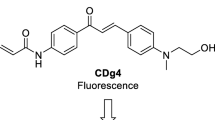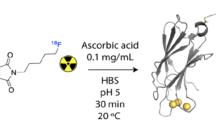Abstract
Purpose
The purpose of this study was to investigate whether 44Sc-labeled puromycin can be utilized for imaging of protein synthesis in vivo.
Methods
For micro-positron emission tomographic (μPET) studies, 20–25 MBq of [44Sc]-DOTA-puromycin was administered to tumor-bearing rats, and animals were scanned for 1 h dynamically. Results were further validated by dissecting organs and tissues of the animals after the measurement and in vitro blocking experiments using puromycin or cycloheximide to block protein synthesis.
Results
μPET images of tumor-bearing rats showed significant tumor uptake of [44Sc]-DOTA-puromycin and a clear-cut tumor visualization. In both blocking experiments, cellular uptake of [44Sc]-DOTA-puromycin ([44Sc]-DOTA-Pur) could be suppressed by blocking protein synthesis.
Conclusions
We report for the first time successful μPET imaging with 44Sc obtained from a 44Ti/44Sc generator, as well as noninvasive μPET imaging of ribosomal activity, respectively protein synthesis, with a puromycin-based radiopharmaceutical and the direct correlation between cellular uptake of [44Sc]-DOTA-Pur and protein synthesis.







Similar content being viewed by others
References
Yarmolinsky MB, Haba GL (1959) Inhibition by puromycin of amino acid incorporation into protein. Proc Natl Acad Sci (USA) 45(12):1721–1729
Nathans D (1964) Puromycin inhibition of protein synthesis: incorporation of puromycin into peptide chains. Proc Natl Acad Sci (USA) 51:585–592
Miyamoto-Sato E, Nemoto N, Kobayashi K et al (2000) Specific bonding of puromycin to full-length protein at the C-terminus. Nucleic Acids Res 28(5):1176–1182
Starck SR, Roberts RW (2002) Puromycin oligonucleotides reveal steric restrictions for ribosome entry and multiple modes of translation inhibition. RNA 8:15
Haubner R (2010) PET radiopharmaceuticals in radiation treatment planning—synthesis and biological characteristics. Radiother Oncol 96(3):280–287
Nemoto N, Miyamoto-Sato E, Yanagawa H (1999) Fluorescence labeling of the C-terminus of proteins with a puromycin analogue in cell-free translation systems. FEBS Lett 462(1–2):43–46
Rösch F, Knapp F (eds) (2004) Radionuclide generators. The Netherlands: Kluwer Academic Publishers. vol. 4, p 81–118
Filosofov DV, Loktionova NS, Rösch F (2010) A 44Ti/44Sc radionuclide generator for potential application of 44Sc-based PET-radiopharmaceuticals. Radiochim Acta 98(3):149–156
Pruszyński M, Loktionova NS, Filosofov DV et al (2010) Post-elution processing of 44Ti/44Sc generator-derived 44Sc for clinical application. Appl Radiat Isot 68(9):1636–1641
Jager PL, de Korte MA, Lub-de Hooge MN et al (2005) Molecular imaging: what can be used today. Cancer Imaging 5(Spec No A):S27–S32
Smith-Jones PM, Stolz B, Bruns C et al (1994) Gallium-67/gallium-68-[DFO]-octreotide—a potential radiopharmaceutical for PET imaging of somatostatin receptor-positive tumors: synthesis and radiolabeling in vitro and preliminary in vivo studies. J Nucl Med 35(2):317–325
Foss CA, Mease RC, Fan H et al (2005) Radiolabeled small-molecule ligands for prostate-specific membrane antigen: in vivo imaging in experimental models of prostate cancer. Clin Cancer Res 11(11):4022–4028
Smith J, Traut R, Blackburn G et al (1965) Action of puromycin in polyadenylic acid-directed polylysine synthesis. J Mol Biol 13:617–628
Meyer GJ, Macke H, Schuhmacher J et al (2004) 68Ga-labelled DOTA-derivatised peptide ligands. Eur J Nucl Med Mol Imaging 31(8):1097–1104
Roivainen A, Tolvanen T, Salomaki S et al (2004) 68Ga-labeled oligonucleotides for in vivo imaging with PET. J Nucl Med 45(2):347–355
Acknowledgments
This project was subsidized by the Ministry of Education, Youth and Sports of the Czech Republic: Project NPV II 2B06165.
We thank Dr. Nicole Bausbacher, Department of Nuclear Medicine, University Medicine, Mainz, Germany, and Barbara Biesalski for outstanding support on μPET imaging.
We thank Dr. Matthias Miederer, Department of Nuclear Medicine, University Medicine Mainz, Germany, for his support in fulfilling the requirements of the national animal protection laws.
Conflicts of interest
None.
Author information
Authors and Affiliations
Corresponding author
Additional information
This study forms a part of the dissertations of S. Eigner and D. R. Beckford Vera.
Rights and permissions
About this article
Cite this article
Eigner, S., Vera, D.R.B., Fellner, M. et al. Imaging of Protein Synthesis: In Vitro and In Vivo Evaluation of 44Sc-DOTA-Puromycin. Mol Imaging Biol 15, 79–86 (2013). https://doi.org/10.1007/s11307-012-0561-3
Published:
Issue Date:
DOI: https://doi.org/10.1007/s11307-012-0561-3




